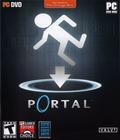In 2019, Nvidia's Lightspeed Studios released Quake II RTX. For the most part, it was the same game as the original from 1997, from the map design to the geometry, textures, and animations to the point where you could employ the same strategies that helped you all those years ago. While this version didn't support the countless existing mods for the game, it gave the game a lighting and shadow overhaul to support the various forms of ray-tracing and DLSS that were built in to the 2000 series of Nvidia's RTX cards. Many hoped that this meant the eventual ray-tracing remasters of classic PC games, but that never happened. Fast-forward to the release of the RTX 4090, and Lightspeed Studios has finally come out with another ray-tracing remaster, this time of Valve's modern classic, Portal.
The plot remains a darkly humorous one, and considering how popular this game was when it was released in 2007, it's a rarity if you aren't already familiar with the premise and memes behind the title. You play an unnamed character, freshly woken up from her slumber and stuck in a pod. You hear a robot's voice that says you've been selected to run through a series of tests. You realize that something is amiss when the robot's voice starts malfunctioning. While you run through these tests with your newfound tool, you're also trying to find a way out of the predicament that you're in.
For the few out there who haven't played this game before, Portal is a first-person puzzle platformer. Just about every one of the puzzles involves you finding a way to reach the exit either through the use of pressure switches, generators that need to be activated by balls of energy, or a combination of the above and more. The big gimmick is the use of portals. Initially, the portals are a means to reach two different points in the room without the normal stairs or visible doors to lead you there. Eventually, physics come into play, as you have to create situations where you're launching yourself or blocks across chasms or over walls.
If you're playing this fresh, you'll be amazed at everything on offer. The individual puzzles are fairly easy to solve once you come to grips with the mechanics, but there are a few brainteasers that'll stump you good. The mechanics are used in inventive ways, and you'll inadvertently discover solutions via unusual means, such as using turrets in place of blocks. The game's dry humor (courtesy of the robot GLADoS) has the perfect delivery; you'll laugh even if it takes you a while to grasp the absurdity of some situations. What really makes the package work is how it all comes together in a way that seems perfect. The overall run time is short enough that it doesn't feel like the game has run out of tricks yet, but you'll want to play with the mechanics some more. It cannot be understated how influential this title was for the genre, even today. This isn't the first game that uses the first-person perspective for physics puzzles, but it is the one that prompted a bunch of others to follow in its footsteps. Just about every game like this on the PC blatantly references this as the inspiration, so much so that it has become an example of a game becoming shorthand for describing a genre.
Portal with RTX isn't necessarily a new game, but it's a mod for the existing version of Portal. The only way to launch this version is to launch the base game on Steam and select the RTX version before it boots up. Since it is a mod, you also have to hit ALT+Insert to bring up the specific RTX graphical options. You will need the absolute latest game drivers from Nvidia to run this, as anything below 527.37 causes the game to freeze immediately upon entering the title screen. You also have to keep in mind that any other mods won't work with this active, at least until they get updated with the latest textures to get RTX features active.
Even with those other caveats in mind, you'll need some beefy hardware to make the game playable with the RTX mod. Nvidia recommends at least a RTX 3060 with a Core i7-6700 or Ryzen 5 3600, just to run at 1080p 30fps on the high preset. If you want to get to 60fps at 1080p, you'll need a RTX 3080 and a Core i7-9700, but you'll still be fine if you have a Ryzen 5 3600. Jump to 4K 60fps, and you'll need a Ryzen 9 5900 or Core i7-12700K and a RTX 4080.
All of those configurations require you to run the game with DLSS on, and based on our tests, the game really does need that. We tried the game at 4K using the RTX 4090 and a Ryzen 7 5800X, and without DLSS, we hovered around the low 40fps range. Turning on DLSS 3, and that got us to between 75-80fps most of the time. Considering that this was built using Nvidia's own RTX Remix, it should give you a good idea of what to expect once that technology comes out and people start working on modding classic PC games.
Should you be in possession of the right hardware, you'll find the mod to be a very transformative experience. Observation rooms are now given life thanks to the ability to see things inside, like monitors that keep displaying code. Glass has a more reflective quality, while the pressure buttons now have some transparency. The overall lighting of the levels is darker, but it makes the light stand out more, like the gleam from energy balls and failed portal beams. Find special cubes hidden via codes, and you'll see how ray tracing gets handled in clearer reflections and cloth shadowing. You'll even notice the light from the cubes when they bounce across the dull steel walls.
Part of the allure comes from the various lighting tricks at play. Another part comes from the redone texture work that does a good job of providing realistic light bounces across the various surfaces. Watch gunfire behind a glass wall, and the muzzle flash is much different than when you see it reflected on smooth glass or dull steel. In some cases, the new lighting effects give you a better idea for how puzzles are solved, since you have a much clearer path about where things like generators are pointed toward and where energy balls bounce — in addition to the scorch marks on the wall. The RTX work is enough to make the 15-year-old title look like a proper, modern game.
The only issue when it comes to the graphics has to do with some of the issues that DLSS 3 is currently facing. For example, the containment room you're in has a visible overhead light over your glass bed that gets blurry whenever you move. Load into a level, and everything is a blurry mess until a second or two later, after the correct textures blend in. To be fair, the load times are quick overall, so the blurry textures only appear during the elevator rides, but it is noticeable enough to mention.
Portal remains a masterpiece of a game. Even more than 15 years later, the game still hits its marks, from puzzle design to length and everything in between. Portal with RTX adds to that by sprucing up the graphics enough that it immediately rivals many modern releases on more advanced game engines. The high system requirements, along with the breaking of some core functionality, restricts who can enjoy the improvements, but the sting doesn't hurt as much due to the fact that it's free. If you are fine with those caveats, give Portal with RTX a spin, whether this is the first time you're playing it — or the 50th.
Score: 8.5/10
More articles about Portal










 Set in the mysterious Aperture Science Laboratories, Portal is a puzzle game designed to change the way players approach, manipulate, and surmise the possibilities in a given environment.
Set in the mysterious Aperture Science Laboratories, Portal is a puzzle game designed to change the way players approach, manipulate, and surmise the possibilities in a given environment.















